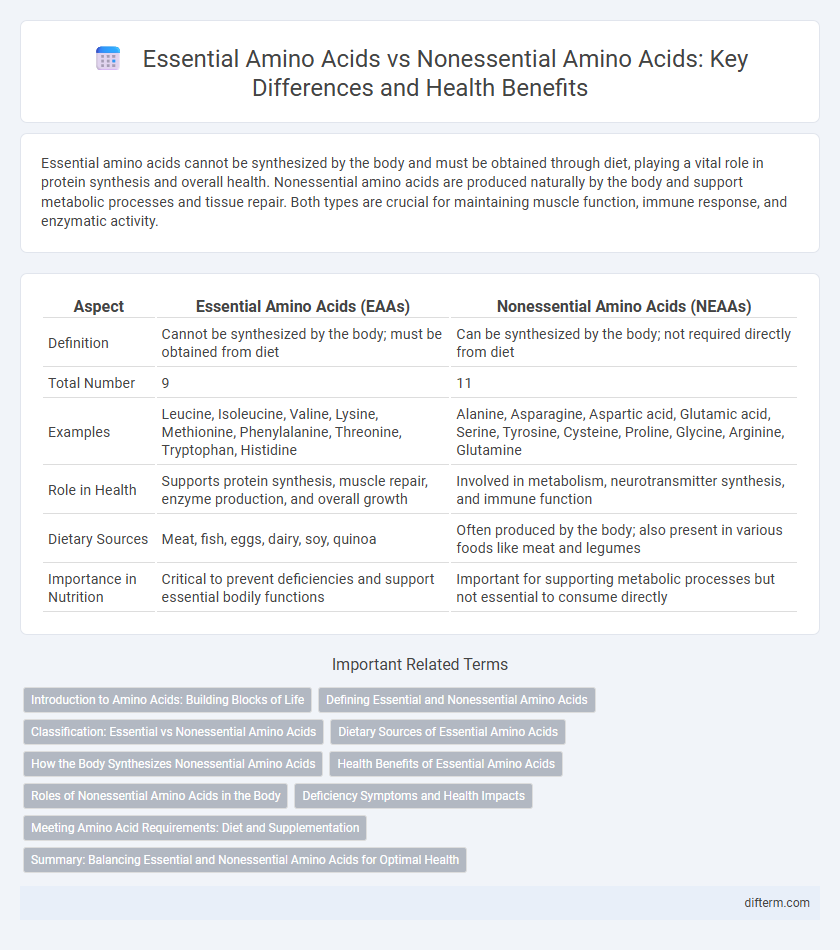Essential amino acids cannot be synthesized by the body and must be obtained through diet, playing a vital role in protein synthesis and overall health. Nonessential amino acids are produced naturally by the body and support metabolic processes and tissue repair. Both types are crucial for maintaining muscle function, immune response, and enzymatic activity.
Table of Comparison
| Aspect | Essential Amino Acids (EAAs) | Nonessential Amino Acids (NEAAs) |
|---|---|---|
| Definition | Cannot be synthesized by the body; must be obtained from diet | Can be synthesized by the body; not required directly from diet |
| Total Number | 9 | 11 |
| Examples | Leucine, Isoleucine, Valine, Lysine, Methionine, Phenylalanine, Threonine, Tryptophan, Histidine | Alanine, Asparagine, Aspartic acid, Glutamic acid, Serine, Tyrosine, Cysteine, Proline, Glycine, Arginine, Glutamine |
| Role in Health | Supports protein synthesis, muscle repair, enzyme production, and overall growth | Involved in metabolism, neurotransmitter synthesis, and immune function |
| Dietary Sources | Meat, fish, eggs, dairy, soy, quinoa | Often produced by the body; also present in various foods like meat and legumes |
| Importance in Nutrition | Critical to prevent deficiencies and support essential bodily functions | Important for supporting metabolic processes but not essential to consume directly |
Introduction to Amino Acids: Building Blocks of Life
Essential amino acids are crucial nutrients the body cannot synthesize and must be obtained through diet, supporting protein synthesis and overall metabolic functions. Nonessential amino acids are produced within the body and contribute to tissue repair, enzyme production, and neurotransmitter synthesis. Both types of amino acids serve as fundamental building blocks of life, playing vital roles in cellular processes and maintaining physiological homeostasis.
Defining Essential and Nonessential Amino Acids
Essential amino acids are those that the human body cannot synthesize and must be obtained through dietary sources, including histidine, isoleucine, leucine, lysine, methionine, phenylalanine, threonine, tryptophan, and valine. Nonessential amino acids, such as alanine, asparagine, and glutamine, can be produced endogenously by the body and do not require direct dietary intake. Understanding the distinction between essential and nonessential amino acids is crucial for optimizing nutrition and supporting vital physiological functions like protein synthesis and metabolic regulation.
Classification: Essential vs Nonessential Amino Acids
Essential amino acids are those that the human body cannot synthesize and must be obtained through diet, including leucine, isoleucine, and valine. Nonessential amino acids, such as alanine and glutamine, are produced internally by the body and do not require dietary intake. Understanding the classification of amino acids is crucial for optimizing protein metabolism and supporting overall health.
Dietary Sources of Essential Amino Acids
Essential amino acids must be obtained through diet because the body cannot synthesize them. Rich dietary sources include animal products such as meat, eggs, and dairy, as well as plant-based options like quinoa, soy, and buckwheat. Consuming a variety of these foods ensures adequate intake of all nine essential amino acids necessary for protein synthesis and overall health.
How the Body Synthesizes Nonessential Amino Acids
The body synthesizes nonessential amino acids through metabolic pathways involving the transamination of intermediates from the Krebs cycle and glycolysis, such as oxaloacetate and alpha-ketoglutarate. Enzymes like aminotransferases facilitate the transfer of amino groups to these carbon skeletons, enabling the creation of amino acids like alanine, glutamate, and aspartate. This biosynthesis process reduces reliance on dietary intake for nonessential amino acids, ensuring continuous protein synthesis and metabolic function.
Health Benefits of Essential Amino Acids
Essential amino acids play a critical role in protein synthesis, muscle repair, and overall metabolic health, as the body cannot produce them and must obtain them through diet. They support immune function, hormone regulation, and neurotransmitter production, which are vital for maintaining optimal physical and mental health. In contrast, nonessential amino acids can be synthesized by the body but do not provide the same direct benefits in supporting essential physiological functions tied to dietary intake.
Roles of Nonessential Amino Acids in the Body
Nonessential amino acids play vital roles in bodily functions such as protein synthesis, neurotransmitter production, and immune system support. They contribute to cellular repair, metabolic processes, and nitrogen balance, maintaining overall physiological health. Though synthesized by the body, adequate levels of nonessential amino acids are crucial for optimal muscle growth and tissue maintenance.
Deficiency Symptoms and Health Impacts
Deficiency in essential amino acids can lead to impaired protein synthesis, resulting in symptoms such as muscle wasting, fatigue, and weakened immune function. Nonessential amino acid deficiencies, while less common, may cause issues like poor wound healing and compromised neurotransmitter production. Both types significantly impact metabolic processes, but essential amino acid shortages pose a greater risk due to their inability to be synthesized by the body.
Meeting Amino Acid Requirements: Diet and Supplementation
Meeting amino acid requirements involves balancing essential amino acids, which the body cannot synthesize and must be obtained through diet, with nonessential amino acids that the body can produce. Complete protein sources such as meat, dairy, and soy provide all essential amino acids, while plant-based diets may require careful combination of foods like legumes and grains to achieve a full amino acid profile. Supplementation with branched-chain amino acids (BCAAs) or essential amino acid blends can support muscle recovery and overall health, especially in individuals with increased protein demands or dietary restrictions.
Summary: Balancing Essential and Nonessential Amino Acids for Optimal Health
Balancing essential and nonessential amino acids is crucial for optimal health, as essential amino acids must be obtained through diet while nonessential amino acids are synthesized by the body. Consuming a varied diet rich in high-quality proteins from sources like meat, dairy, legumes, and quinoa ensures adequate intake of all amino acids necessary for muscle repair, enzyme function, and neurotransmitter synthesis. Maintaining this balance supports metabolic processes, immune function, and overall physiological well-being.
essential amino acids vs nonessential amino acids Infographic

 difterm.com
difterm.com